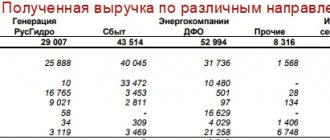The end of the month is approaching. We see that we have done a good job, there is a profit, there is money in the cash register too. At this point, a classic dilemma arises: how much of these earnings can be taken as dividends without loss for the business?
Where is the balance between “living now” and having a stable business that should generate income for many years and, perhaps, grow into a family business? Unfortunately, there are no universal recipes. The answer will be different for each business. But I’ll tell you what I do myself to put everything into perspective.
First, I answer myself four questions:
How to determine whether a business is profitable?
Is there positive cash flow?
How much working capital will I need for the next quarter?
What reserves should there be in case of circumstances that cannot be foreseen?
Let's start in order.
Net profit - what is it?
Net profit is the profit that remains with the enterprise after it has made all mandatory cash payments.
This indicator characterizes the final financial result achieved by the company by the end of the reporting period. The list of purposes for which the profits can be used is not established by law. This means that the owners of the company (namely, their competence, according to subsection 7, paragraph 2, article 33 of the Federal Law “On Limited Liability Companies” dated 02/08/1998 No. 14, includes making such decisions) have the right to direct it for any purpose .
As a rule, net profit is allocated to:
- for the acquisition of new fixed assets (buildings, equipment, etc.);
- creation of a reserve fund;
- increasing the size of the authorized capital of the enterprise;
- bonuses for employees;
- payment of debts incurred in previous periods;
- payment of dividends to the founders, which, according to paragraph 1 of Art. 43 of the Tax Code of the Russian Federation, any income received by a participant in a company as a result of the distribution of its existing profits generated after payment of all taxes is recognized.
Dividends can be issued both in cash and in kind (property, securities, etc.) form.
Stages of enterprise profit planning
1. Setting goals
At the first stage, the target profit should be set in accordance with the strategic plans of the enterprise. Moreover, the target profit of the enterprise must be realistic, based on capabilities and resources.
2. Determining the expected sales volume
The most important stage in the process of planning the revenue and profit of an enterprise. A business needs to forecast sales in order to achieve its profit goals. Sales volume is expected to take into account market trends, industry trends and the results of the competitive analysis performed. Here you can see how planning of income and profit of an enterprise are related.
3. Cost Estimation
At this stage, the company estimates its expenses for the planned sales volume. Expenses can be determined from historical data. If the enterprise is new, then you can use data from a similar organization in the same industry.
4. Determination of profit
Profit is calculated as:
- Planned gross profit = Planned sales revenue – Cost of sales
- Planned operating profit = Planned gross profit – Operating expenses
- Planned net profit = Planned operating profit – Interest on loans – taxes
- Retained earnings = Planned net income - Dividends
| Plan for the 2nd half of 2018 | |
| TOTAL REVENUE | 13 275 000 |
| Revenue from core activities | 12 900 000 |
| Additional revenue (transport) | 375 000 |
| COST OF SALES | 9 923 077 |
| GROSS PROFIT | 3 351 923 |
| OPERATING COSTS | 1 643 100 |
| Management salary | 540 000 |
| Other salary | 126 000 |
| Personnel and training costs | 292 700 |
| Marketing, PR, website support and sales department costs | 24 000 |
| Rent | 81 600 |
| Office and household expenses | 209 800 |
| Fare | 181 800 |
| Connection | 115 200 |
| Equipment depreciation | |
| Buildings and constructions | |
| Equipment | |
| Vehicles | |
| Office equipment | |
| Other OS | |
| other expenses | 72 000 |
| OPERATING PROFIT | 1 708 823 |
| INTEREST ON LOANS | |
| PROFIT BEFORE TAX | 1 708 823 |
| TAXES | 596 330 |
| NET PROFIT | 1 112 493 |
| DIVIDENDS | 160 000 |
| RETAINED EARNINGS | 952 493 |
Table 1. Enterprise profit planning using an example
Videos of past webinars on the topic “Management Accounting / IFRS”
Look
When is net profit distributed to the LLC?
According to paragraph 3 of Art. 28 Federal Law No. 14, the distribution of profits in an LLC must be made within 60 days from the date of adoption of the relevant decision (except for cases where the constituent documents establish a shorter period). Violation of this deadline entails the occurrence of the equity holder under Art. 395 of the Civil Code of the Russian Federation the right to demand payment not only of the amount of dividends, but also of funds for the illegal use of money belonging to him.
A participant who has not received his share of the profit, in accordance with clause 4 of Art. 28 of the same article has the right to demand its payment within 3 years from the date of its distribution. After the expiration of the specified period, the funds acquire the status of retained earnings and can be used in the interests of the enterprise.
If the co-founders of the company have not decided to distribute profits among its participants, an individual participant will not be able to claim part of the money received by the company even in court. This point of view is set out in sub. “b” clause 15 of the resolution of the Plenums of the Supreme Court and the Supreme Arbitration Court of the Russian Federation “On some issues...” dated December 9, 1999 No. 90/14. The courts motivated their opinion by the fact that the involvement of authorities in resolving such issues violates the right of participants to conduct free voting and entails interference in the normal functioning of society.
Profit distribution decision
The distribution of LLC profits among the participants is made on the basis of a decision made by its co-founders. According to the provisions of paragraphs. 1–3 tbsp. 28 Federal Law No. 14, such a decision must contain:
- expression of will of all participants on the distribution of profits received;
- information about what share of the funds received is subject to transfer to the co-founders of the company;
- information about the timing of the payment and the form in which it will be made.
The decision must be made by a simple majority of votes and recorded in the minutes of the meeting of the co-founders of the LLC. Funds can be distributed based on the results of the quarter, half-year or year (Clause 1, Article 28 of Federal Law No. 14).
According to paragraph 2 of Art. 28 Federal Law No. 14, the division of funds is carried out in proportion to the shares in the authorized capital owned by the participants. At the same time, the charter of the enterprise may determine another, different from the traditional, procedure for distributing profits in the LLC. The decision on the basis of which such a procedure was recorded in the constituent document must be made unanimously by the co-owners of the company. It is worth remembering that the tax authorities do not recognize profits distributed without taking into account the size of the shares owned by the co-founders as dividends (letter of the Federal Tax Service of the Russian Federation dated August 16, 2012 No. ED-4-3 / [email protected] ).
Standard method of enterprise profit planning
Positive economic theory and practice are objective, that is, based on facts. The positive method focuses on the analysis of economic statistics and data, and the conclusions based on these indicators (for example, whether corporate growth will increase dividends to shareholders).
The regulatory method is subjective and aims to determine what the economic future of the company or investor will be. That is, regulatory practice is a form of valuation that can introduce subjective opinions into accounting (for example, what would happen if a company raised interest rates to support corporate growth). Regulatory planning is concerned with future events, not past data.
The positive method is best used to explain past financial events as well as current financial condition. This method is typically used to create financial documents, balance sheets, or cash flow statements.
The normative method is best used when developing future economic policies. Therefore, company plans or market strategies included in business plans can be considered normative.
The procedure for distributing profits in an LLC
The distribution of profits in an LLC between participants can be carried out in the following sequence:
- An analysis of the financial results of the enterprise is carried out. At this stage, the net asset value (the difference between assets and liabilities) is calculated. The procedure for calculating these indicators depends on which tax system (OSNO, simplified tax system, UTII, etc.) the organization uses.
- A meeting of the company's co-founders is held. During the event, a decision is made on the distribution of generated profits between the participants of the LLC. The decision made must be recorded in the minutes of the meeting. Details of how this document is compiled are described here.
- Funds in the amount established by the general decision of the owners of the company are distributed among them and transferred through non-cash transfer. The list of purposes for which funds can be transferred in cash (established by the Directive of the Central Bank of the Russian Federation “On the implementation ...” of October 7, 2013 No. 3073-U) does not include expenses for the payment of dividends.
Basics of Profit Planning
To lay a solid foundation for profit planning in an enterprise, it is necessary to adhere to the following fundamental principles:
- Profit planning is a process of making management decisions. Essentially, management decision making involves the task of managing variables that can affect revenues, costs, and investments.
- The key to the success of profit planning is the competence of management to plan the activities of the enterprise. Management must have absolute confidence in its ability to set realistic goals and develop effective means for the enterprise to achieve those goals.
- A comprehensive profit planning program involves the participation of all levels of management. In order to competently engage in profit planning, management, and especially top management, must have a correct understanding of the nature and characteristics of profit planning, and be sure that this particular management technique is more preferable for a given situation.
What rights to a share of the profits does a new LLC member have?
If during the reporting period a new participant was included in the company, a logical question arises: in what amount should dividends be paid to him? The legislator does not give precise instructions in this regard, so co-owners of an LLC should be guided by the provisions of clause 2 of Art. 28 Federal Law No. 14, according to which the distribution of funds is made in proportion to the size of the shares owned by the co-founders (regardless of how long they belong to their owners).
Thus, the new LLC participant will receive a profit corresponding to the size of his share. For example, if the share is ½, then the new participant will receive half the profit, and if ¾ - three quarters of the profit.
How to distribute profits in an LLC with one founder?
Distribution of profits in an LLC with one founder has its own nuances. In particular, the only participant, in accordance with the provisions of Art. 39 Federal Law No. 14, makes all decisions (including where the funds received by the company will be sent) independently. In this case, the protocol is not drawn up - the owner of the company will only need to document his decision, indicating the following information:
- Company name;
- date and place of creation of the document;
- Document Number;
- information about the sole owner of the company;
- the amount of funds to be paid, as well as the deadline for their transfer;
- the period for which the profit was made.
The sole founder, like the meeting of partners, can use only part of the profit received by the company as dividends for their own needs. The other part remains within society and is used for any production or organizational purposes.
Problems of profit planning in an enterprise
Profit planning in an enterprise as a decision-making tool involves the creation of specific products, the development of long-term plans and annual profile plans for short periods, which will be prepared after the development of a sales plan, production plan, administrative expenses budget, indirect expenses budget, etc.
The objectives of profit planning are thus similar to those of integrated budgeting. It focuses on a rational approach to integrated planning, which in turn emphasizes management of objectives. It is important to note that profit planning is associated not only with the accounting function, but also with other business functions that can be considered and used independently of the overall management process.
Distribution of profits from previous years in LLC
Often in practice, a situation arises when the profit received by a company is not distributed for several years and is reflected in the company’s balance sheet in account 84 (retained earnings). In this case, the participants have a natural question: is it possible to distribute such funds and use them to pay dividends?
The legislator does not establish exact deadlines within which it is necessary to distribute profits, so you can address this issue even after the end of the period in which it was received. The legislation does not contain a ban on the transfer of such funds to shareholders of the company. This clarification is set out, in particular, in the Resolution of the Presidium of the Supreme Arbitration Court of the Russian Federation dated June 25, 2013 No. 18087/12.
According to the provisions of paragraph 1 of Art. 28 Federal Law No. 14, participants have the right to decide on the procedure for distributing available funds received by the company once every quarter, half-year or year, and this rule applies only to funds received in the current reporting period. This means that the profit received based on the results of the completed periods can be distributed among the company’s shareholders at any time.
The decision made by the co-owners of the company must contain information about exactly what profits are to be distributed. Otherwise, there are no differences from the standard procedure for dividing money: the decision is made and formalized in the manner established by the provisions of Federal Law No. 14.
In what cases does a ban on profit distribution arise?
In paragraph 1 of Art. 29 Federal Law No. 14 determines that the owners of the company do not have the right to decide on the distribution of profits in the LLC in their favor if:
- the company is in the process of bankruptcy proceedings or the payment of dividends may lead to its insolvency;
- the size of the authorized capital and reserve funds of the enterprise exceeds the value of its net assets or the payment of dividends will entail the occurrence of such a situation;
- the authorized capital of the company has not been fully paid;
- one of the founders left the company, but did not receive compensation for the share transferred to her.
The first and second situations are grounds for a ban on the payment of dividends even if the corresponding decision has already been made by the co-founders of the company (this is indicated by clause 2 of Article 29 of Federal Law No. 14).
Once the factor that interferes with the distribution of profits ceases, the funds can be transferred to the founders of the company in the general manner.










